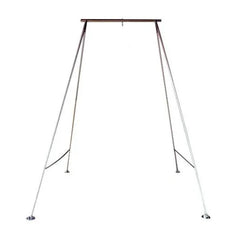Splits are one of the most sought after skills for aerialists, yogis and dancers alike. Many people make the mistake of assuming that splits are something that a person naturally can or can’t do, but this simply isn’t the case! Just like any other aerial skill, the splits are something that can be conditioned and strengthened with time and consistency. By using these tips and techniques, you can learn how to create a go-to splits conditioning regimen to help you meet your flexibility goals.
Incorporating Passive & Active Stretches
You might think all stretches are created equal, but there are actually several types of stretching that can benefit your practice, and they can generally be broken down as either passive or active. In layman's terms, a passive stretch is performed on a relaxed muscle using some form of force, like your bodyweight. On the other hand, active stretches involve some form of movement that engages your muscle fibers in order to generate the stretch. By utilizing both styles of stretches in your routine, you can improve the range of your flexibility as well as the strength of your muscles.
Targeting the Right Muscles

Once you understand passive vs. active stretching, you can put them to use by targeting the primary muscles used in a split; your hamstrings and hip flexors. Ideally, you should select two to three passive and active stretches for targeting either your hamstrings and hip flexors.
Passive Hip Flexor Stretch: Frog Pose

Begin on all fours with your knees directly under your hips. Slowly slide your knees out until you are able to rest your elbows on the floor. Hold for 20 - 30 seconds.
Passive Hamstring Stretch: Half Split

Begin in a kneeling position, then bring one leg out straight in front of you. Gently lean over your straight leg, reaching for your toes. Hold for 20 - 30 seconds each side.
Active Hip Flexor Stretch: Side Lunge Transitions

Begin with your legs wide and slow sink down to a low side lunge, sitting back into your hips. Without using your hands, rise back up and slowly transition to the opposite side. Repeat for 3 to 5 rounds.
Active Hamstring Stretch: Pyramid to Low Lunge

Begin in a pyramid pose with your legs hip width apart and one leg slightly in front, the other behind. Lean over your front leg, deeply stretching your hamstring. Slowly bend your knees to drop down into a low runner’s lunge. Slowly straighten your legs back to pyramid. Repeat for 3 - 5 rounds each side.
Practice and Patience

Ultimately, conditioning for the splits comes down to consistency, not force. Keep in mind that injuries due to overstretching are extremely common and any stretch should only cause mild discomfort, not pain. Flexibility is a skill that develops over time, so it’s important to offer yourself lots of patience in your journey to the splits. And as you practice, be sure to show off your improvements on your aerial hammock, aerial silks or aerial hoop! With a generous amount of practice and patience, you’ll be hitting your splits like never before.
Photos by Mary Jo Gruber on Dark Purple Aerial Silks.



Leave a comment